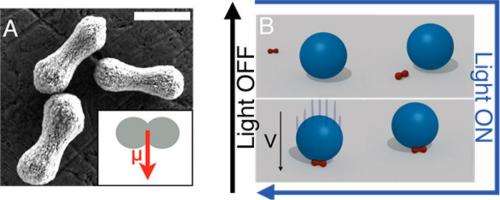November 8, 2013 feature
'Peanut' particles could be used to build micro-scale factories

(Phys.org) —One of the main components of a factory is the robots that transport and assemble objects of varying shapes and sizes. When scaling down to the micro level, the steel and wiring that these robots are made of must be replaced by something else—one new idea is peanut-shaped particles that are propelled with light and steered by magnetic fields.
As demonstrated in a new study by researchers at New York University, these colloidal particles can act as "shepherds" that can carry flocks of cargo several times their own size. The work could not only open up new possibilities for designing complex micro-sized factories, but could also have applications in creating micro-sized biomimetic systems such as artificial muscles.
The group of physicists, Jérémie Palacci, Stefano Sacanna, Adrian Vatchinsky, Paul M. Chaikin, and David J. Pine at New York University, have published a paper on the colloidal particles capable of transporting large cargos in a recent issue of the Journal of the American Chemical Society.
The colloidal particles are made from hematite, a magnetic iron oxide, and can be synthesized in various shapes such as cubes, ellipses, and peanuts. Here, the researchers focused on peanut-shaped colloids that are about 1.5 μm long. To make the colloids respond better to light, the researchers etched them to give them a rough surface.
In their experiments, the researchers placed the peanut colloids in a solution with hydrogen peroxide, and then illuminated them through a microscope with blue light. Under light activation, the colloids self-propel toward the surface of the solution. By applying a weak magnetic field, the researchers could change the direction of the self-propulsion and effectively steer the colloids.
The researchers explain that the mechanism behind this self-propulsion involves the blue light causing the hydrogen peroxide in the solution to decompose into water and oxygen. This decomposition creates a chemical gradient near the peanut colloids, which causes unbalanced osmotic pressure that in turn induces a flow which propels the colloids.
When immersed and illuminated in a solution with a pH of 8.5, the hematite peanut colloids attract colloids made of other materials, such as silica and polystyrene. These cargo particles have diameters of up to 20 μm, making them several times larger than the peanut colloids. When the light is turned off, the peanut colloids stop moving and release their cargo. The researchers explain that the attraction between the colloids is due to negative phoresis, and becomes repulsive at a lower pH.
The researchers demonstrated that the cargo-carrying peanut colloids can be steered along a predetermined pathway in addition to being steered by a magnetic field. Channels can be made etching a line or creating a nanocrack in the substrate, providing a microscale version of ground rail transportation.
Altogether, the capabilities of peanut colloids—which can be thought of as microrobots—to load, transport, and unload cargo in a controlled way open up many new opportunities for engineering at the microscale.
"In the current paper we showed that we could direct the particle along a straight line, previously textured in the substrate," Palacci told Phys.org. "It would quite interesting to be able to draw more complex patterns of nano-tracks on the substrate. Then playing with the light, one could pick up a colloid somewhere, bring it to a place with no light, drop off the cargo, go somewhere else... and then assemble something really complicated without external intervention by an operator. Fordism brought to the micro scale!"
More information: Jérémie Palacci, et al. "Photoactivated Colloidal Dockers for Cargo Transportation." Journal of the American Chemical Society. DOI: 10.1021/ja406090s
Journal information: Journal of the American Chemical Society
© 2013 Phys.org. All rights reserved.



















